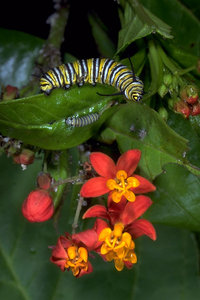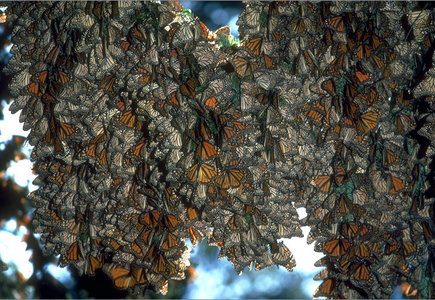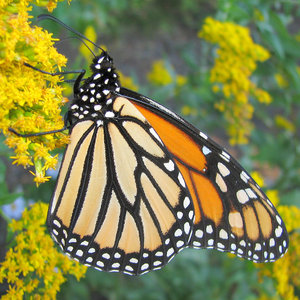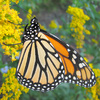Danaus plexippus
The Monarch Butterfly
Andrew V. Z. BrowerIntroduction
The monarch is one of the best known butterfly species. Although native to North and South America, it has expanded its distribution to Australia, many Pacific islands, and a few places in Europe. Monarch larvae, like those of many other Danaini, feed on milkweeds of the family Asclepiadaceae, from which they sequester cardiac glycosides that often render them unpalatable to potential predators. The species is perhaps best known for its annual migrations, from eastern North America to the mountains of central Mexico, and from western North America to the coast of California. The butterflies rest for the cool winter months in large aggregations which may contain tens of millions of individuals.



Left: Monarch larva feeding on milkweed host plant at Poco Sol (Caribbean slope below Monteverde), Costa Rica. Right: Overwintering monarchs covering a tree branch at Alpha Monarch research site, Mexico. Images © Greg and Marybeth Dimijian
References
Brower AVZ, and Jeansonne MM. 2004. Geographical populations and "subspecies" of New World monarch butterflies (Nymphalidae) share a recent origin and are not phylogenetically distinct. Ann. Entomol. Soc. Amer. 97: 519-523.
Brower LP. 1995. Understanding and misunderstanding the migration of the monarch butterfly (Nymphalidae) in North America: 1857-1995. J. Lepid. Soc. 49: 304-385.
Solensky, M. J. and K. S. Oberhauser, eds. 2004. The Monarch Butterfly: Biology and Conservation. Cornell University Press, Ithaca.
Information on the Internet
- Monarch Watch
- Monarch Butterfly. Journey North.
- The Miracle of Migration. The Whyfiles. University of Wisconsin.
Title Illustrations

| Scientific Name | Danaus plexippus |
|---|---|
| Location | Longwood Gardens, Kennett Square, Pennsylvania, USA |
| Specimen Condition | Live Specimen |
| Sex | Male |
| Source | Stained Glass Butterfly |
| Source Collection | Flickr |
| Image Use |
 This media file is licensed under the Creative Commons Attribution-NonCommercial-NoDerivs License - Version 2.0. This media file is licensed under the Creative Commons Attribution-NonCommercial-NoDerivs License - Version 2.0.
|
| Copyright | © 2006 Marty DeAngelo |
| Scientific Name | Danaus plexippus |
|---|---|
| Location | Farm Pond Park, Framingham, Massachusetts, USA |
| Specimen Condition | Live Specimen |
| Sex | Female |
| Source | bug of the day |
| Source Collection | Flickr |
| Image Use |
 This media file is licensed under the Creative Commons Attribution-NonCommercial-ShareAlike License - Version 2.0. This media file is licensed under the Creative Commons Attribution-NonCommercial-ShareAlike License - Version 2.0.
|
| Copyright | © 2006 Jenn Forman Orth |
About This Page

Middle Tennessee State University, Murfreesboro, Tennessee, USA
Correspondence regarding this page should be directed to Andrew V. Z. Brower at
Page copyright © 2009
 Page: Tree of Life
Danaus plexippus . The Monarch Butterfly.
Authored by
Andrew V. Z. Brower.
The TEXT of this page is licensed under the
Creative Commons Attribution License - Version 3.0. Note that images and other media
featured on this page are each governed by their own license, and they may or may not be available
for reuse. Click on an image or a media link to access the media data window, which provides the
relevant licensing information. For the general terms and conditions of ToL material reuse and
redistribution, please see the Tree of Life Copyright
Policies.
Page: Tree of Life
Danaus plexippus . The Monarch Butterfly.
Authored by
Andrew V. Z. Brower.
The TEXT of this page is licensed under the
Creative Commons Attribution License - Version 3.0. Note that images and other media
featured on this page are each governed by their own license, and they may or may not be available
for reuse. Click on an image or a media link to access the media data window, which provides the
relevant licensing information. For the general terms and conditions of ToL material reuse and
redistribution, please see the Tree of Life Copyright
Policies.
- First online 13 November 2006
- Content changed 02 August 2007
Citing this page:
Brower, Andrew V. Z. 2007. Danaus plexippus . The Monarch Butterfly. Version 02 August 2007 (under construction). http://tolweb.org/Danaus_plexippus/76926/2007.08.02 in The Tree of Life Web Project, http://tolweb.org/










 Go to quick links
Go to quick search
Go to navigation for this section of the ToL site
Go to detailed links for the ToL site
Go to quick links
Go to quick search
Go to navigation for this section of the ToL site
Go to detailed links for the ToL site